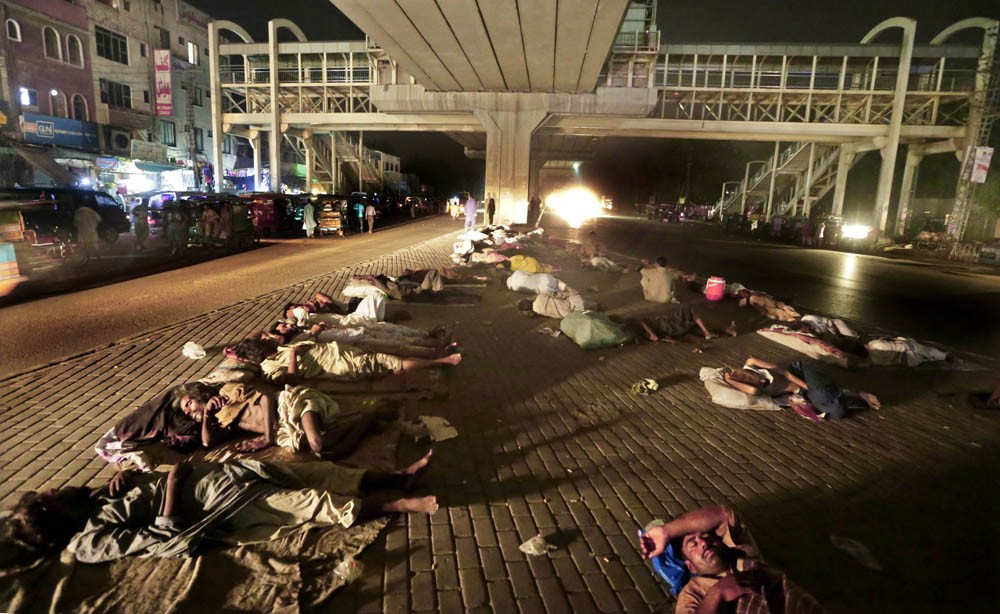
Every day is a struggle for around 185,000 people who sleep on the streets of Lahore every night

After midnight last Sunday, in complete darkness, Muhammad Ismail, 55, a resident of Chichawatni, was wide awake. He stared into empty space as he puffed his cigarette. "My income is so low that I cannot afford to rent a living space for myself. I sleep on the floor outside a shop and this sheet is my only asset. I have two pairs of clothes. I give one for washing and wear the other," he says.
Ismail has chosen to rough sleep near the Jamaat-ud-Dawa mosque, Al-Qadsia, as "God fearing people distribute free food thrice a day among labourers and students in this area," he says.
He came to Lahore from Chichawatni to earn a living about 15 years ago. He works as a labourer and is able to earn Rs7000 a month. He rarely visits his family but sends them a chunk of his monthly earning regularly.
Before work began on the controversial Orange Train, Ismail lived near Chauburji.
Ismail is not the only person living on the roadside. At least 100 people, dhol walas, masseurs, labourers, rough sleep with him on Peer Bahawal Sher Road and Multan Road.
According to a survey conducted by Shelter for Homeless People there are around 185,000 homeless people in Lahore. Of these 98 per cent are male while two per cent are female. "Around 18 per cent are children who are vulnerable to sexual abuse," says Nasrullah Bukhari, chairman of the organisation.
"We found out that in the vicinity of Batapur, Kot Abdul Malik and Thokar Niaz Baig, the police arrested innocent homeless people just to show their performance and to please their officers. Some policemen extorted money from them during search operations," Bukhari adds.
He accepts that there may be criminals among them, but "they are mostly harmless people".
Shelter for Homeless People raised funds and distributed three marla plots to 300 homeless people in Kot Abdul Malik area. "There are old people’s homes that accommodate the elderly. These are built either by the government or charitable organisations but there is nothing for the homeless between 30 to 50 years of age," says Bukhari.
Dr Haider Ashraf, DIG Operations, Lahore Police rejects allegations levelled against the policemen by Bukhari. "They check homeless people from the security point of view. After all, there can be a terrorist in the garb of a homeless person. Policemen let them sleep on roadsides after checking their CNIC and arrest criminals only. Police do not arrest them just to claim good performance."
Akmal Ovaisi, President Tanzeem Al-Fajar Pakistan and Member Provincial Narcotics Control Committee, Government of Punjab, says that a huge population of homeless people is addicted to drugs. "They are found around Data Darbar, Chauburji, Shahi Qila and Bhaati Chowk. They get free food from dastarkhans in Mozang, Chauburji, Abbott Road, Bahria Town and Data Darbar."
The spaces under the metro bus overhead bridges are safe havens for the homeless. They sleep there throughout the night without any fear of bad weather.
Ovaisi laments that the government does not maintain a record for the homeless. "They are not part of the urban planning schemes. These people sleep in green belts, on the sides of the canal or outside shops in big markets. They are exposed to extreme heat of the summer and cold of the winter. The government must provide shelter, funds and medical care to them from the Bait-ul-Maal," he adds.
Gulab Irshad, Manager Auqaf, Data Darbar, says the shrine is the only place where countless homeless people come to get food on daily basis. "We have no record of them. The homeless sleep outside the shrine. Unfortunately, the Bait-ul-Maal and social security department don’t give them any financial assistance. So, sometimes they do commit crimes like pick-pocketing and theft. They do this as they do not have any source of income for survival."
Irshad says, "If we find a girl who has eloped from her house we hand her over to Dar-ul-Aman within no time. If we find an unaccompanied child in the shrine’s premises, he is handed over to the Child Protection Bureau."